Business Law Assignment: Case Study Analysis and Legal Advice
VerifiedAdded on 2021/06/16
|11
|2835
|21
Report
AI Summary
This report provides an analysis of two business law case studies. The first case examines misrepresentation in a contract, where a buyer claims to have relied on false statements about a business's profitability. The report considers the elements of a valid contract, misrepresentation, and relevant case law like *Harvey v Facey*, *Horsfall v Thomas*, and *Redgrave v Hurd*, concluding that a claim for misrepresentation can be filed. The second case study addresses negligence, where a family suffers harm from a contaminated product. The report analyzes the elements of negligence, duty of care, breach of duty, causation, and remoteness of damages, referencing cases like *Donoghue v Stevenson*, *O’Dwyer v Leo Buring Pty Ltd*, and *Barnett v Chelsea & Kensington Hospital*. The report concludes that the manufacturing company is liable for damages due to a breach of duty of care. Both case studies are evaluated using relevant legislation, case law, and legal principles to provide comprehensive legal advice on the given scenarios.
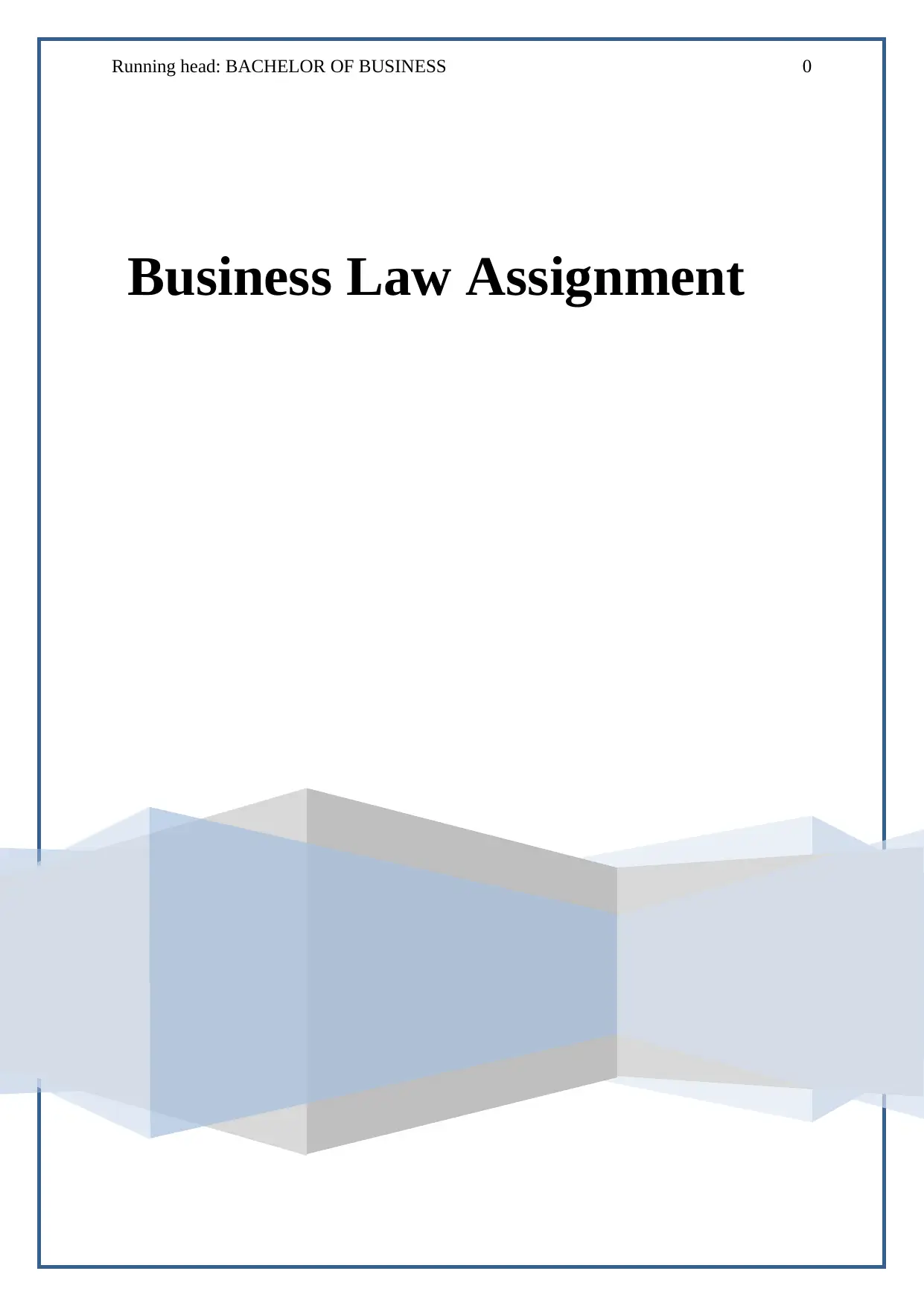
Running head: BACHELOR OF BUSINESS 0
Business Law Assignment
Business Law Assignment
Paraphrase This Document
Need a fresh take? Get an instant paraphrase of this document with our AI Paraphraser
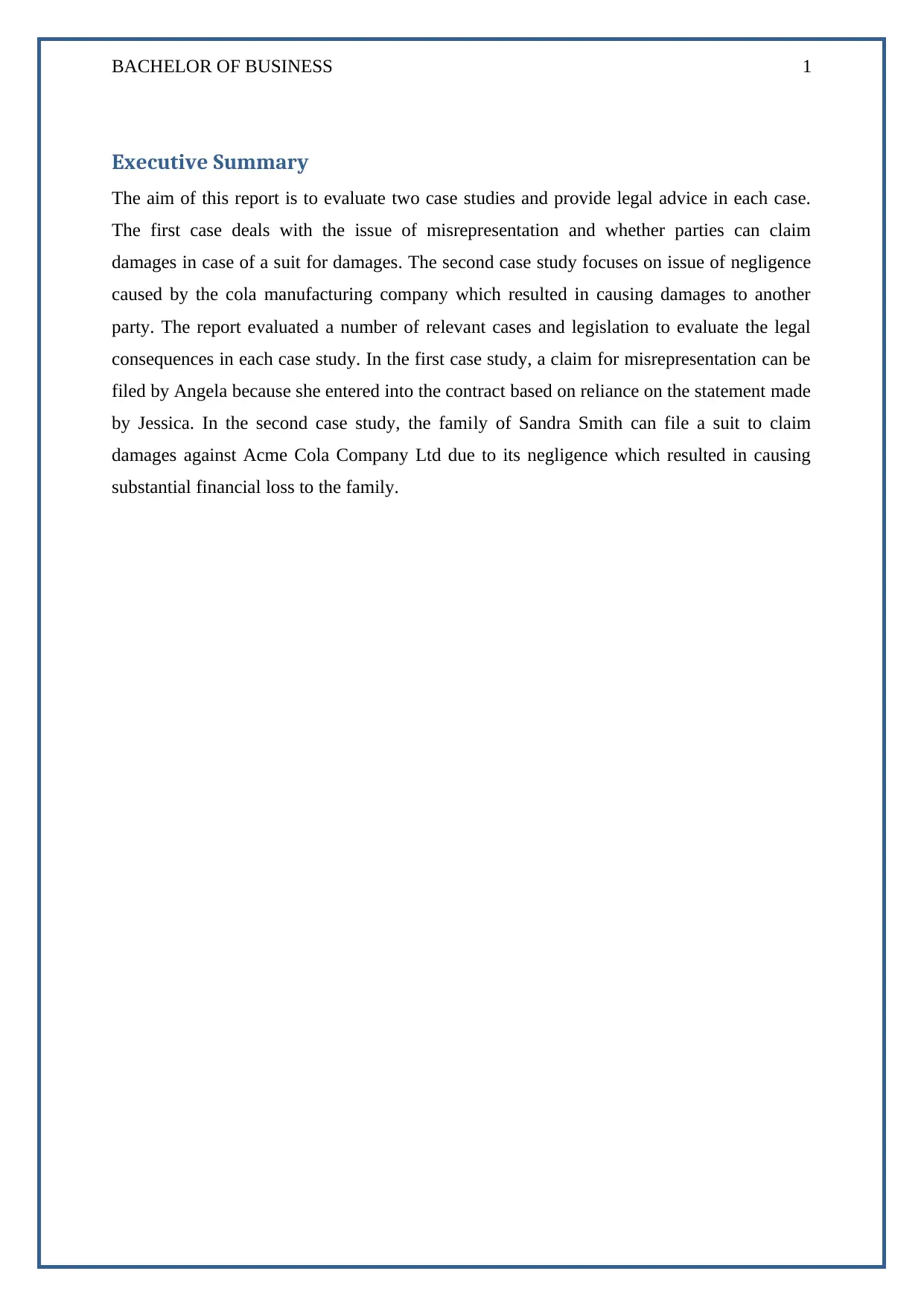
BACHELOR OF BUSINESS 1
Executive Summary
The aim of this report is to evaluate two case studies and provide legal advice in each case.
The first case deals with the issue of misrepresentation and whether parties can claim
damages in case of a suit for damages. The second case study focuses on issue of negligence
caused by the cola manufacturing company which resulted in causing damages to another
party. The report evaluated a number of relevant cases and legislation to evaluate the legal
consequences in each case study. In the first case study, a claim for misrepresentation can be
filed by Angela because she entered into the contract based on reliance on the statement made
by Jessica. In the second case study, the family of Sandra Smith can file a suit to claim
damages against Acme Cola Company Ltd due to its negligence which resulted in causing
substantial financial loss to the family.
Executive Summary
The aim of this report is to evaluate two case studies and provide legal advice in each case.
The first case deals with the issue of misrepresentation and whether parties can claim
damages in case of a suit for damages. The second case study focuses on issue of negligence
caused by the cola manufacturing company which resulted in causing damages to another
party. The report evaluated a number of relevant cases and legislation to evaluate the legal
consequences in each case study. In the first case study, a claim for misrepresentation can be
filed by Angela because she entered into the contract based on reliance on the statement made
by Jessica. In the second case study, the family of Sandra Smith can file a suit to claim
damages against Acme Cola Company Ltd due to its negligence which resulted in causing
substantial financial loss to the family.
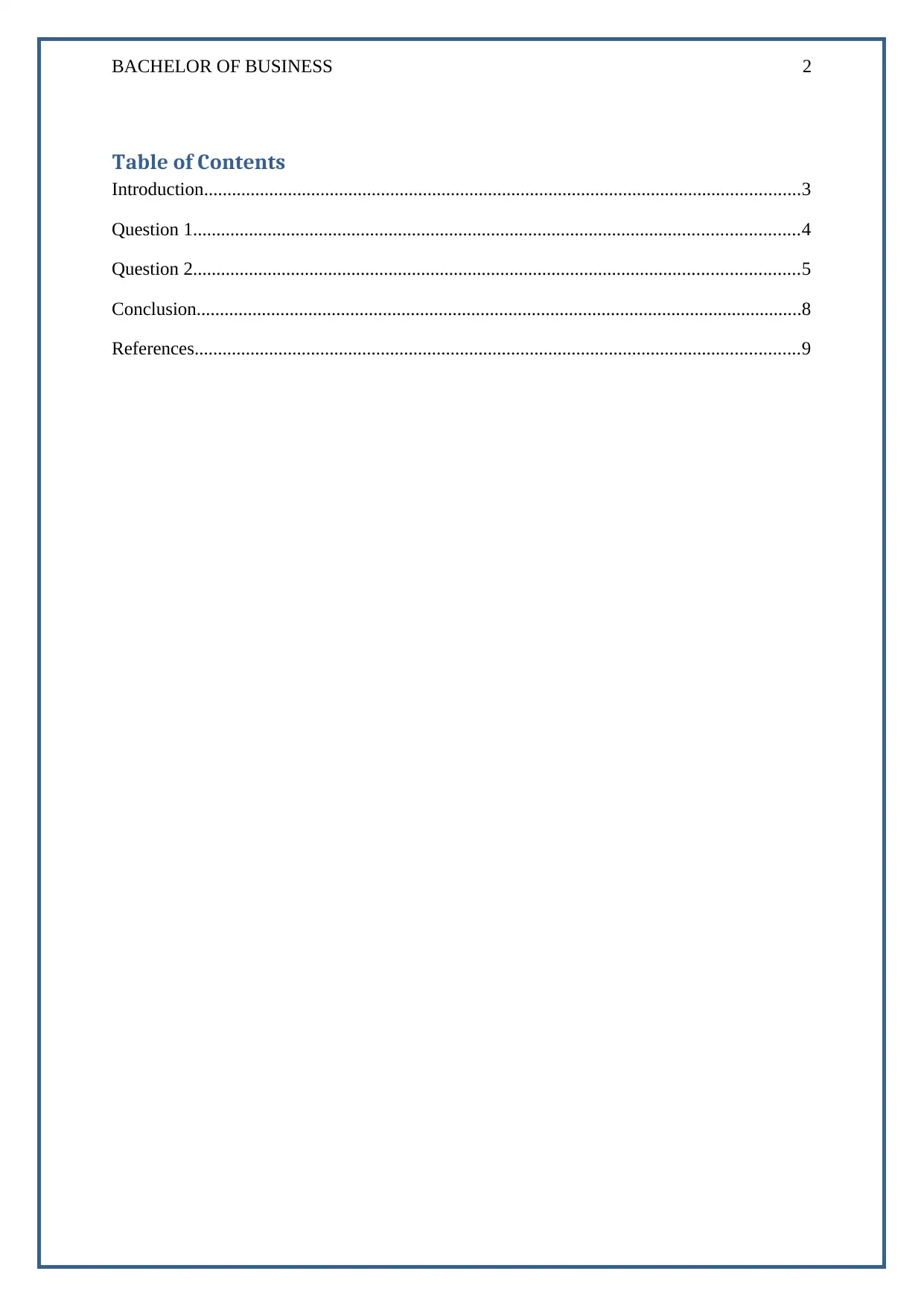
BACHELOR OF BUSINESS 2
Table of Contents
Introduction................................................................................................................................3
Question 1..................................................................................................................................4
Question 2..................................................................................................................................5
Conclusion..................................................................................................................................8
References..................................................................................................................................9
Table of Contents
Introduction................................................................................................................................3
Question 1..................................................................................................................................4
Question 2..................................................................................................................................5
Conclusion..................................................................................................................................8
References..................................................................................................................................9
⊘ This is a preview!⊘
Do you want full access?
Subscribe today to unlock all pages.

Trusted by 1+ million students worldwide
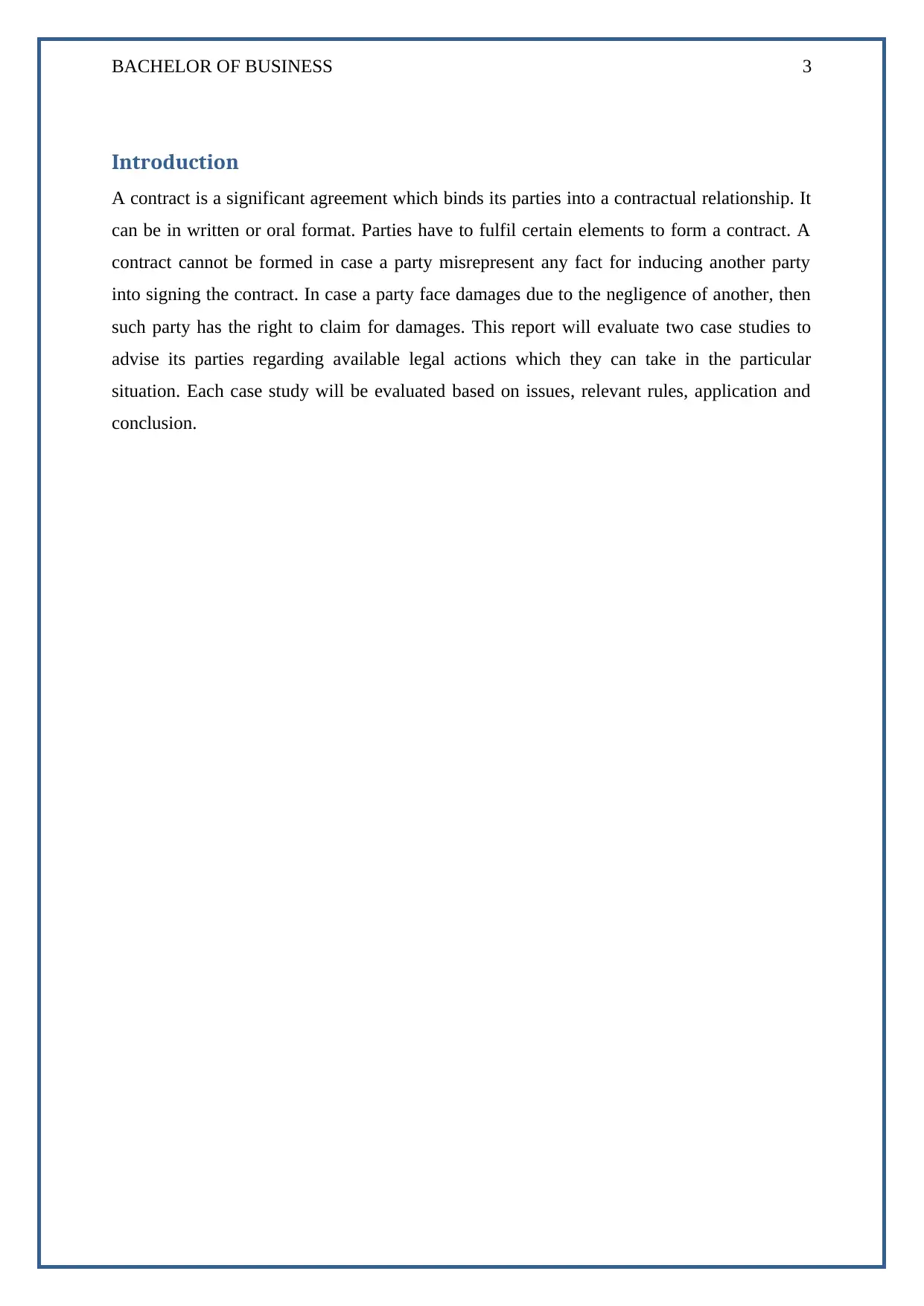
BACHELOR OF BUSINESS 3
Introduction
A contract is a significant agreement which binds its parties into a contractual relationship. It
can be in written or oral format. Parties have to fulfil certain elements to form a contract. A
contract cannot be formed in case a party misrepresent any fact for inducing another party
into signing the contract. In case a party face damages due to the negligence of another, then
such party has the right to claim for damages. This report will evaluate two case studies to
advise its parties regarding available legal actions which they can take in the particular
situation. Each case study will be evaluated based on issues, relevant rules, application and
conclusion.
Introduction
A contract is a significant agreement which binds its parties into a contractual relationship. It
can be in written or oral format. Parties have to fulfil certain elements to form a contract. A
contract cannot be formed in case a party misrepresent any fact for inducing another party
into signing the contract. In case a party face damages due to the negligence of another, then
such party has the right to claim for damages. This report will evaluate two case studies to
advise its parties regarding available legal actions which they can take in the particular
situation. Each case study will be evaluated based on issues, relevant rules, application and
conclusion.
Paraphrase This Document
Need a fresh take? Get an instant paraphrase of this document with our AI Paraphraser
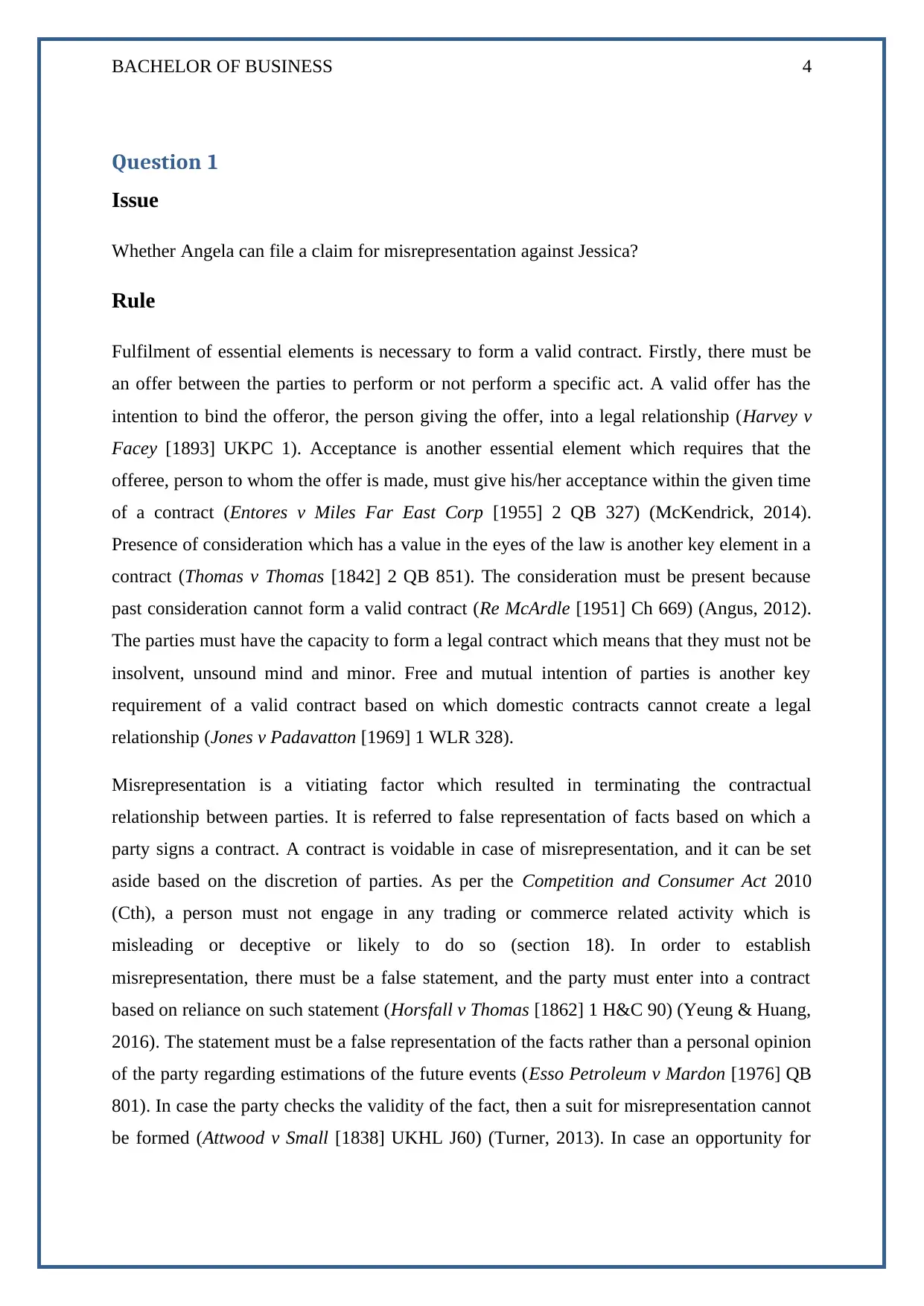
BACHELOR OF BUSINESS 4
Question 1
Issue
Whether Angela can file a claim for misrepresentation against Jessica?
Rule
Fulfilment of essential elements is necessary to form a valid contract. Firstly, there must be
an offer between the parties to perform or not perform a specific act. A valid offer has the
intention to bind the offeror, the person giving the offer, into a legal relationship (Harvey v
Facey [1893] UKPC 1). Acceptance is another essential element which requires that the
offeree, person to whom the offer is made, must give his/her acceptance within the given time
of a contract (Entores v Miles Far East Corp [1955] 2 QB 327) (McKendrick, 2014).
Presence of consideration which has a value in the eyes of the law is another key element in a
contract (Thomas v Thomas [1842] 2 QB 851). The consideration must be present because
past consideration cannot form a valid contract (Re McArdle [1951] Ch 669) (Angus, 2012).
The parties must have the capacity to form a legal contract which means that they must not be
insolvent, unsound mind and minor. Free and mutual intention of parties is another key
requirement of a valid contract based on which domestic contracts cannot create a legal
relationship (Jones v Padavatton [1969] 1 WLR 328).
Misrepresentation is a vitiating factor which resulted in terminating the contractual
relationship between parties. It is referred to false representation of facts based on which a
party signs a contract. A contract is voidable in case of misrepresentation, and it can be set
aside based on the discretion of parties. As per the Competition and Consumer Act 2010
(Cth), a person must not engage in any trading or commerce related activity which is
misleading or deceptive or likely to do so (section 18). In order to establish
misrepresentation, there must be a false statement, and the party must enter into a contract
based on reliance on such statement (Horsfall v Thomas [1862] 1 H&C 90) (Yeung & Huang,
2016). The statement must be a false representation of the facts rather than a personal opinion
of the party regarding estimations of the future events (Esso Petroleum v Mardon [1976] QB
801). In case the party checks the validity of the fact, then a suit for misrepresentation cannot
be formed (Attwood v Small [1838] UKHL J60) (Turner, 2013). In case an opportunity for
Question 1
Issue
Whether Angela can file a claim for misrepresentation against Jessica?
Rule
Fulfilment of essential elements is necessary to form a valid contract. Firstly, there must be
an offer between the parties to perform or not perform a specific act. A valid offer has the
intention to bind the offeror, the person giving the offer, into a legal relationship (Harvey v
Facey [1893] UKPC 1). Acceptance is another essential element which requires that the
offeree, person to whom the offer is made, must give his/her acceptance within the given time
of a contract (Entores v Miles Far East Corp [1955] 2 QB 327) (McKendrick, 2014).
Presence of consideration which has a value in the eyes of the law is another key element in a
contract (Thomas v Thomas [1842] 2 QB 851). The consideration must be present because
past consideration cannot form a valid contract (Re McArdle [1951] Ch 669) (Angus, 2012).
The parties must have the capacity to form a legal contract which means that they must not be
insolvent, unsound mind and minor. Free and mutual intention of parties is another key
requirement of a valid contract based on which domestic contracts cannot create a legal
relationship (Jones v Padavatton [1969] 1 WLR 328).
Misrepresentation is a vitiating factor which resulted in terminating the contractual
relationship between parties. It is referred to false representation of facts based on which a
party signs a contract. A contract is voidable in case of misrepresentation, and it can be set
aside based on the discretion of parties. As per the Competition and Consumer Act 2010
(Cth), a person must not engage in any trading or commerce related activity which is
misleading or deceptive or likely to do so (section 18). In order to establish
misrepresentation, there must be a false statement, and the party must enter into a contract
based on reliance on such statement (Horsfall v Thomas [1862] 1 H&C 90) (Yeung & Huang,
2016). The statement must be a false representation of the facts rather than a personal opinion
of the party regarding estimations of the future events (Esso Petroleum v Mardon [1976] QB
801). In case the party checks the validity of the fact, then a suit for misrepresentation cannot
be formed (Attwood v Small [1838] UKHL J60) (Turner, 2013). In case an opportunity for
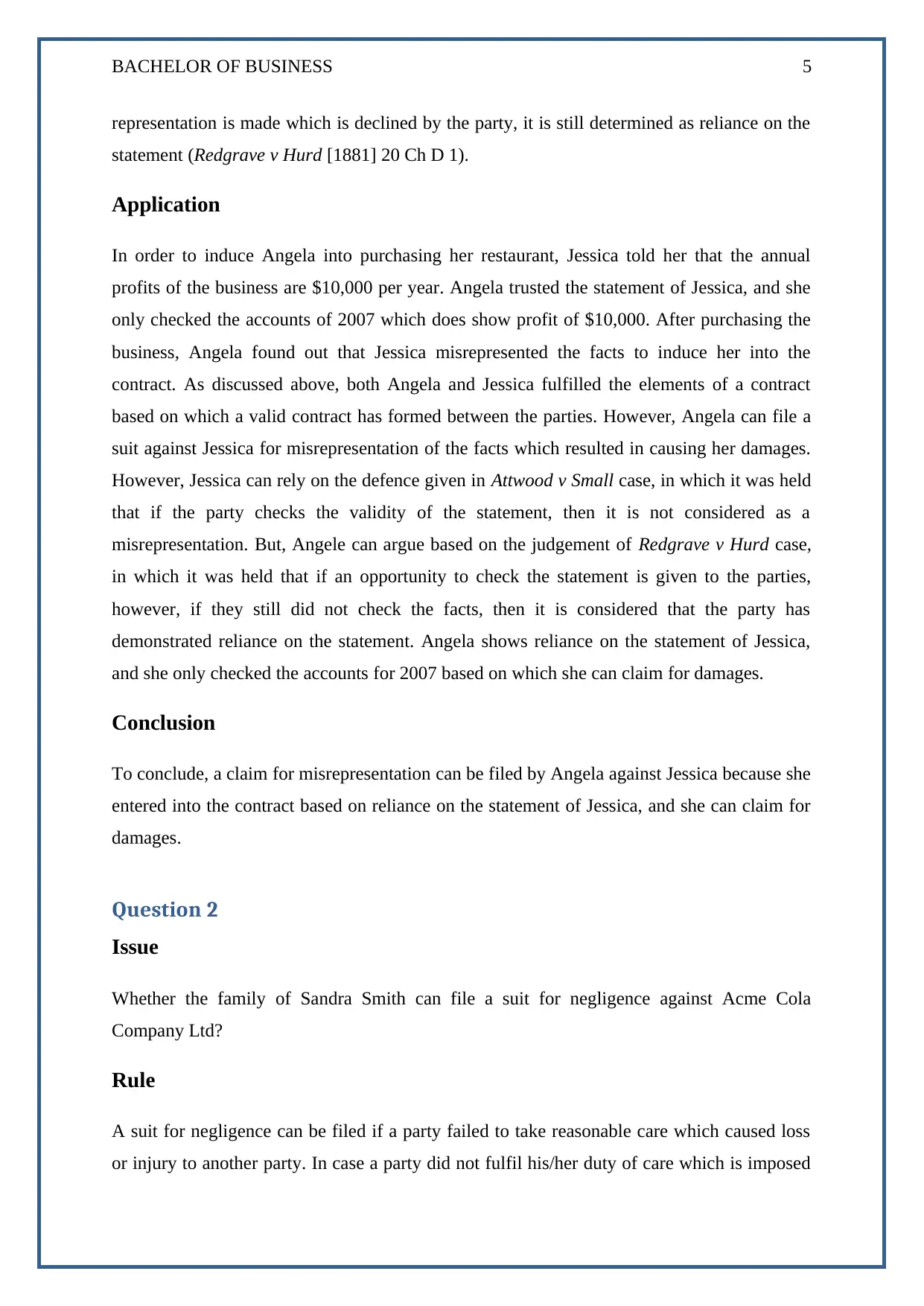
BACHELOR OF BUSINESS 5
representation is made which is declined by the party, it is still determined as reliance on the
statement (Redgrave v Hurd [1881] 20 Ch D 1).
Application
In order to induce Angela into purchasing her restaurant, Jessica told her that the annual
profits of the business are $10,000 per year. Angela trusted the statement of Jessica, and she
only checked the accounts of 2007 which does show profit of $10,000. After purchasing the
business, Angela found out that Jessica misrepresented the facts to induce her into the
contract. As discussed above, both Angela and Jessica fulfilled the elements of a contract
based on which a valid contract has formed between the parties. However, Angela can file a
suit against Jessica for misrepresentation of the facts which resulted in causing her damages.
However, Jessica can rely on the defence given in Attwood v Small case, in which it was held
that if the party checks the validity of the statement, then it is not considered as a
misrepresentation. But, Angele can argue based on the judgement of Redgrave v Hurd case,
in which it was held that if an opportunity to check the statement is given to the parties,
however, if they still did not check the facts, then it is considered that the party has
demonstrated reliance on the statement. Angela shows reliance on the statement of Jessica,
and she only checked the accounts for 2007 based on which she can claim for damages.
Conclusion
To conclude, a claim for misrepresentation can be filed by Angela against Jessica because she
entered into the contract based on reliance on the statement of Jessica, and she can claim for
damages.
Question 2
Issue
Whether the family of Sandra Smith can file a suit for negligence against Acme Cola
Company Ltd?
Rule
A suit for negligence can be filed if a party failed to take reasonable care which caused loss
or injury to another party. In case a party did not fulfil his/her duty of care which is imposed
representation is made which is declined by the party, it is still determined as reliance on the
statement (Redgrave v Hurd [1881] 20 Ch D 1).
Application
In order to induce Angela into purchasing her restaurant, Jessica told her that the annual
profits of the business are $10,000 per year. Angela trusted the statement of Jessica, and she
only checked the accounts of 2007 which does show profit of $10,000. After purchasing the
business, Angela found out that Jessica misrepresented the facts to induce her into the
contract. As discussed above, both Angela and Jessica fulfilled the elements of a contract
based on which a valid contract has formed between the parties. However, Angela can file a
suit against Jessica for misrepresentation of the facts which resulted in causing her damages.
However, Jessica can rely on the defence given in Attwood v Small case, in which it was held
that if the party checks the validity of the statement, then it is not considered as a
misrepresentation. But, Angele can argue based on the judgement of Redgrave v Hurd case,
in which it was held that if an opportunity to check the statement is given to the parties,
however, if they still did not check the facts, then it is considered that the party has
demonstrated reliance on the statement. Angela shows reliance on the statement of Jessica,
and she only checked the accounts for 2007 based on which she can claim for damages.
Conclusion
To conclude, a claim for misrepresentation can be filed by Angela against Jessica because she
entered into the contract based on reliance on the statement of Jessica, and she can claim for
damages.
Question 2
Issue
Whether the family of Sandra Smith can file a suit for negligence against Acme Cola
Company Ltd?
Rule
A suit for negligence can be filed if a party failed to take reasonable care which caused loss
or injury to another party. In case a party did not fulfil his/her duty of care which is imposed
⊘ This is a preview!⊘
Do you want full access?
Subscribe today to unlock all pages.

Trusted by 1+ million students worldwide
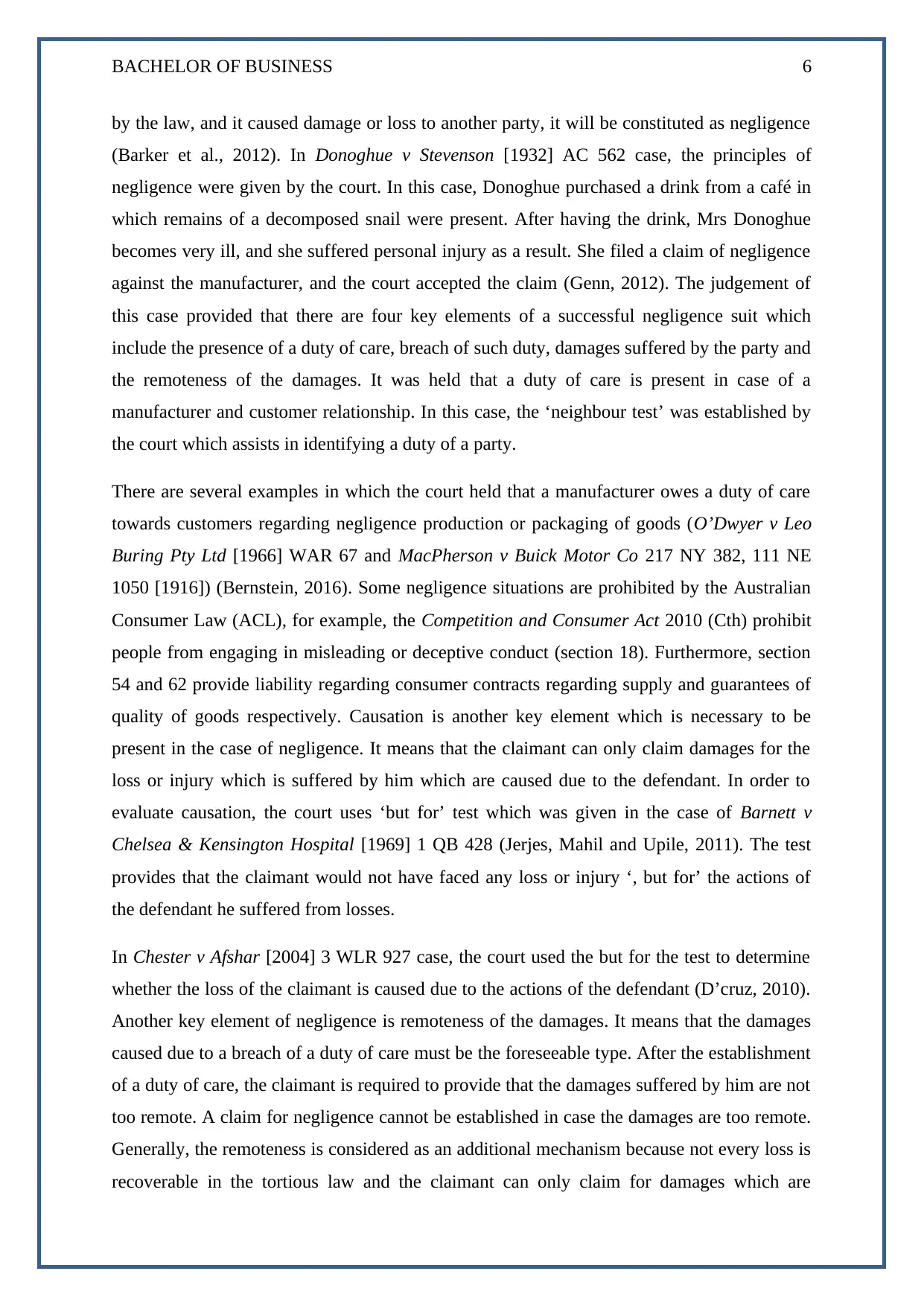
BACHELOR OF BUSINESS 6
by the law, and it caused damage or loss to another party, it will be constituted as negligence
(Barker et al., 2012). In Donoghue v Stevenson [1932] AC 562 case, the principles of
negligence were given by the court. In this case, Donoghue purchased a drink from a café in
which remains of a decomposed snail were present. After having the drink, Mrs Donoghue
becomes very ill, and she suffered personal injury as a result. She filed a claim of negligence
against the manufacturer, and the court accepted the claim (Genn, 2012). The judgement of
this case provided that there are four key elements of a successful negligence suit which
include the presence of a duty of care, breach of such duty, damages suffered by the party and
the remoteness of the damages. It was held that a duty of care is present in case of a
manufacturer and customer relationship. In this case, the ‘neighbour test’ was established by
the court which assists in identifying a duty of a party.
There are several examples in which the court held that a manufacturer owes a duty of care
towards customers regarding negligence production or packaging of goods (O’Dwyer v Leo
Buring Pty Ltd [1966] WAR 67 and MacPherson v Buick Motor Co 217 NY 382, 111 NE
1050 [1916]) (Bernstein, 2016). Some negligence situations are prohibited by the Australian
Consumer Law (ACL), for example, the Competition and Consumer Act 2010 (Cth) prohibit
people from engaging in misleading or deceptive conduct (section 18). Furthermore, section
54 and 62 provide liability regarding consumer contracts regarding supply and guarantees of
quality of goods respectively. Causation is another key element which is necessary to be
present in the case of negligence. It means that the claimant can only claim damages for the
loss or injury which is suffered by him which are caused due to the defendant. In order to
evaluate causation, the court uses ‘but for’ test which was given in the case of Barnett v
Chelsea & Kensington Hospital [1969] 1 QB 428 (Jerjes, Mahil and Upile, 2011). The test
provides that the claimant would not have faced any loss or injury ‘, but for’ the actions of
the defendant he suffered from losses.
In Chester v Afshar [2004] 3 WLR 927 case, the court used the but for the test to determine
whether the loss of the claimant is caused due to the actions of the defendant (D’cruz, 2010).
Another key element of negligence is remoteness of the damages. It means that the damages
caused due to a breach of a duty of care must be the foreseeable type. After the establishment
of a duty of care, the claimant is required to provide that the damages suffered by him are not
too remote. A claim for negligence cannot be established in case the damages are too remote.
Generally, the remoteness is considered as an additional mechanism because not every loss is
recoverable in the tortious law and the claimant can only claim for damages which are
by the law, and it caused damage or loss to another party, it will be constituted as negligence
(Barker et al., 2012). In Donoghue v Stevenson [1932] AC 562 case, the principles of
negligence were given by the court. In this case, Donoghue purchased a drink from a café in
which remains of a decomposed snail were present. After having the drink, Mrs Donoghue
becomes very ill, and she suffered personal injury as a result. She filed a claim of negligence
against the manufacturer, and the court accepted the claim (Genn, 2012). The judgement of
this case provided that there are four key elements of a successful negligence suit which
include the presence of a duty of care, breach of such duty, damages suffered by the party and
the remoteness of the damages. It was held that a duty of care is present in case of a
manufacturer and customer relationship. In this case, the ‘neighbour test’ was established by
the court which assists in identifying a duty of a party.
There are several examples in which the court held that a manufacturer owes a duty of care
towards customers regarding negligence production or packaging of goods (O’Dwyer v Leo
Buring Pty Ltd [1966] WAR 67 and MacPherson v Buick Motor Co 217 NY 382, 111 NE
1050 [1916]) (Bernstein, 2016). Some negligence situations are prohibited by the Australian
Consumer Law (ACL), for example, the Competition and Consumer Act 2010 (Cth) prohibit
people from engaging in misleading or deceptive conduct (section 18). Furthermore, section
54 and 62 provide liability regarding consumer contracts regarding supply and guarantees of
quality of goods respectively. Causation is another key element which is necessary to be
present in the case of negligence. It means that the claimant can only claim damages for the
loss or injury which is suffered by him which are caused due to the defendant. In order to
evaluate causation, the court uses ‘but for’ test which was given in the case of Barnett v
Chelsea & Kensington Hospital [1969] 1 QB 428 (Jerjes, Mahil and Upile, 2011). The test
provides that the claimant would not have faced any loss or injury ‘, but for’ the actions of
the defendant he suffered from losses.
In Chester v Afshar [2004] 3 WLR 927 case, the court used the but for the test to determine
whether the loss of the claimant is caused due to the actions of the defendant (D’cruz, 2010).
Another key element of negligence is remoteness of the damages. It means that the damages
caused due to a breach of a duty of care must be the foreseeable type. After the establishment
of a duty of care, the claimant is required to provide that the damages suffered by him are not
too remote. A claim for negligence cannot be established in case the damages are too remote.
Generally, the remoteness is considered as an additional mechanism because not every loss is
recoverable in the tortious law and the claimant can only claim for damages which are
Paraphrase This Document
Need a fresh take? Get an instant paraphrase of this document with our AI Paraphraser
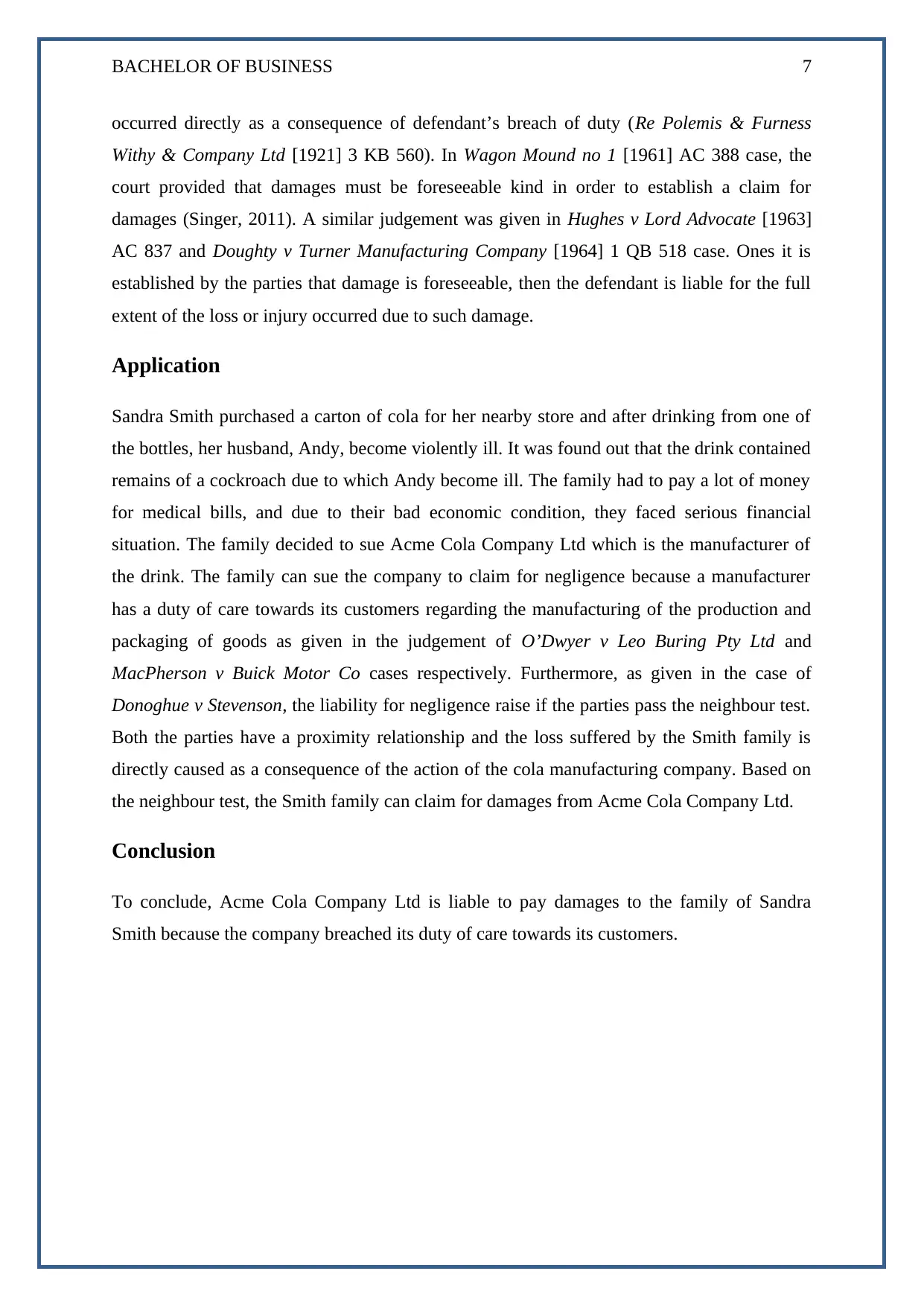
BACHELOR OF BUSINESS 7
occurred directly as a consequence of defendant’s breach of duty (Re Polemis & Furness
Withy & Company Ltd [1921] 3 KB 560). In Wagon Mound no 1 [1961] AC 388 case, the
court provided that damages must be foreseeable kind in order to establish a claim for
damages (Singer, 2011). A similar judgement was given in Hughes v Lord Advocate [1963]
AC 837 and Doughty v Turner Manufacturing Company [1964] 1 QB 518 case. Ones it is
established by the parties that damage is foreseeable, then the defendant is liable for the full
extent of the loss or injury occurred due to such damage.
Application
Sandra Smith purchased a carton of cola for her nearby store and after drinking from one of
the bottles, her husband, Andy, become violently ill. It was found out that the drink contained
remains of a cockroach due to which Andy become ill. The family had to pay a lot of money
for medical bills, and due to their bad economic condition, they faced serious financial
situation. The family decided to sue Acme Cola Company Ltd which is the manufacturer of
the drink. The family can sue the company to claim for negligence because a manufacturer
has a duty of care towards its customers regarding the manufacturing of the production and
packaging of goods as given in the judgement of O’Dwyer v Leo Buring Pty Ltd and
MacPherson v Buick Motor Co cases respectively. Furthermore, as given in the case of
Donoghue v Stevenson, the liability for negligence raise if the parties pass the neighbour test.
Both the parties have a proximity relationship and the loss suffered by the Smith family is
directly caused as a consequence of the action of the cola manufacturing company. Based on
the neighbour test, the Smith family can claim for damages from Acme Cola Company Ltd.
Conclusion
To conclude, Acme Cola Company Ltd is liable to pay damages to the family of Sandra
Smith because the company breached its duty of care towards its customers.
occurred directly as a consequence of defendant’s breach of duty (Re Polemis & Furness
Withy & Company Ltd [1921] 3 KB 560). In Wagon Mound no 1 [1961] AC 388 case, the
court provided that damages must be foreseeable kind in order to establish a claim for
damages (Singer, 2011). A similar judgement was given in Hughes v Lord Advocate [1963]
AC 837 and Doughty v Turner Manufacturing Company [1964] 1 QB 518 case. Ones it is
established by the parties that damage is foreseeable, then the defendant is liable for the full
extent of the loss or injury occurred due to such damage.
Application
Sandra Smith purchased a carton of cola for her nearby store and after drinking from one of
the bottles, her husband, Andy, become violently ill. It was found out that the drink contained
remains of a cockroach due to which Andy become ill. The family had to pay a lot of money
for medical bills, and due to their bad economic condition, they faced serious financial
situation. The family decided to sue Acme Cola Company Ltd which is the manufacturer of
the drink. The family can sue the company to claim for negligence because a manufacturer
has a duty of care towards its customers regarding the manufacturing of the production and
packaging of goods as given in the judgement of O’Dwyer v Leo Buring Pty Ltd and
MacPherson v Buick Motor Co cases respectively. Furthermore, as given in the case of
Donoghue v Stevenson, the liability for negligence raise if the parties pass the neighbour test.
Both the parties have a proximity relationship and the loss suffered by the Smith family is
directly caused as a consequence of the action of the cola manufacturing company. Based on
the neighbour test, the Smith family can claim for damages from Acme Cola Company Ltd.
Conclusion
To conclude, Acme Cola Company Ltd is liable to pay damages to the family of Sandra
Smith because the company breached its duty of care towards its customers.
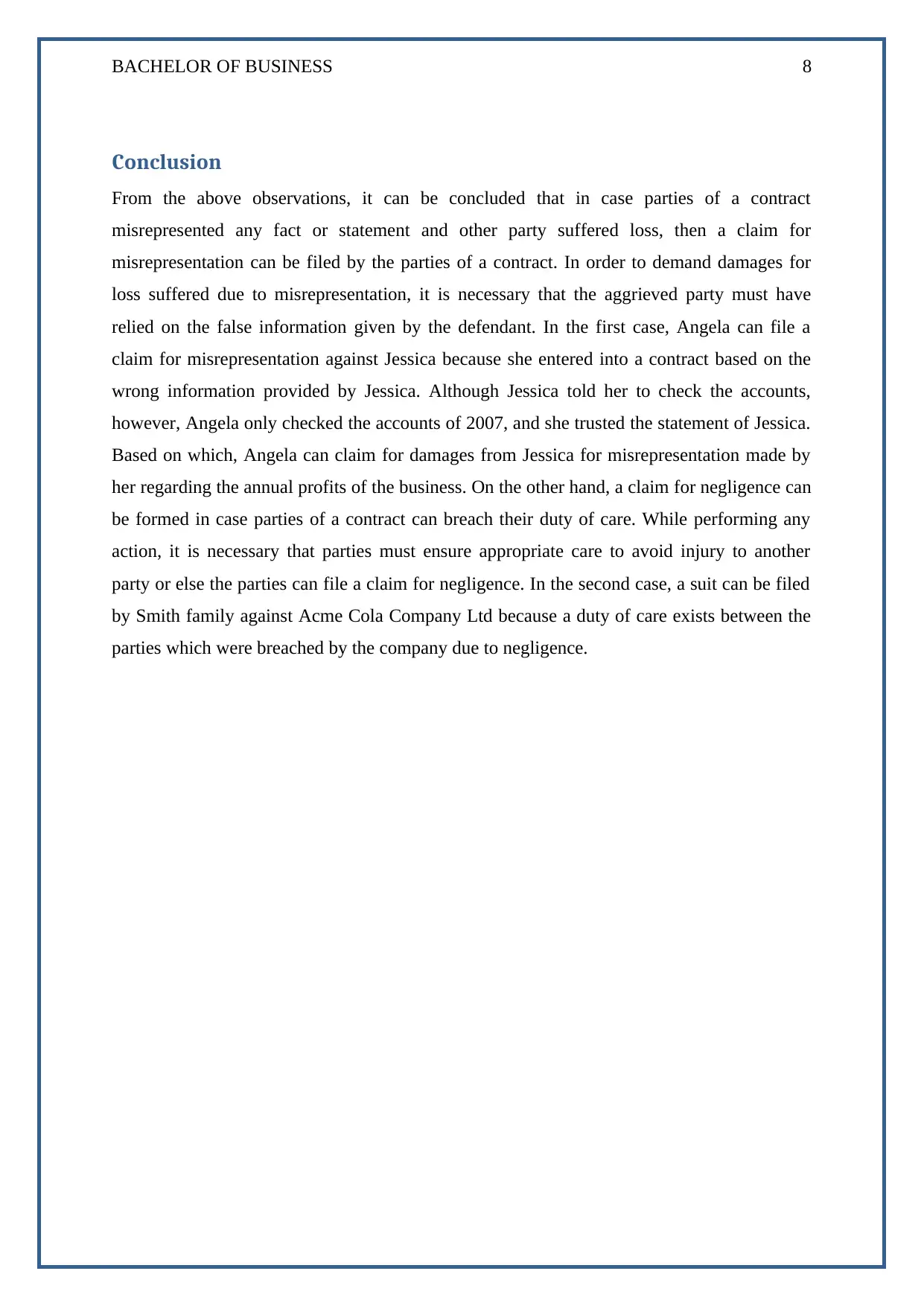
BACHELOR OF BUSINESS 8
Conclusion
From the above observations, it can be concluded that in case parties of a contract
misrepresented any fact or statement and other party suffered loss, then a claim for
misrepresentation can be filed by the parties of a contract. In order to demand damages for
loss suffered due to misrepresentation, it is necessary that the aggrieved party must have
relied on the false information given by the defendant. In the first case, Angela can file a
claim for misrepresentation against Jessica because she entered into a contract based on the
wrong information provided by Jessica. Although Jessica told her to check the accounts,
however, Angela only checked the accounts of 2007, and she trusted the statement of Jessica.
Based on which, Angela can claim for damages from Jessica for misrepresentation made by
her regarding the annual profits of the business. On the other hand, a claim for negligence can
be formed in case parties of a contract can breach their duty of care. While performing any
action, it is necessary that parties must ensure appropriate care to avoid injury to another
party or else the parties can file a claim for negligence. In the second case, a suit can be filed
by Smith family against Acme Cola Company Ltd because a duty of care exists between the
parties which were breached by the company due to negligence.
Conclusion
From the above observations, it can be concluded that in case parties of a contract
misrepresented any fact or statement and other party suffered loss, then a claim for
misrepresentation can be filed by the parties of a contract. In order to demand damages for
loss suffered due to misrepresentation, it is necessary that the aggrieved party must have
relied on the false information given by the defendant. In the first case, Angela can file a
claim for misrepresentation against Jessica because she entered into a contract based on the
wrong information provided by Jessica. Although Jessica told her to check the accounts,
however, Angela only checked the accounts of 2007, and she trusted the statement of Jessica.
Based on which, Angela can claim for damages from Jessica for misrepresentation made by
her regarding the annual profits of the business. On the other hand, a claim for negligence can
be formed in case parties of a contract can breach their duty of care. While performing any
action, it is necessary that parties must ensure appropriate care to avoid injury to another
party or else the parties can file a claim for negligence. In the second case, a suit can be filed
by Smith family against Acme Cola Company Ltd because a duty of care exists between the
parties which were breached by the company due to negligence.
⊘ This is a preview!⊘
Do you want full access?
Subscribe today to unlock all pages.

Trusted by 1+ million students worldwide
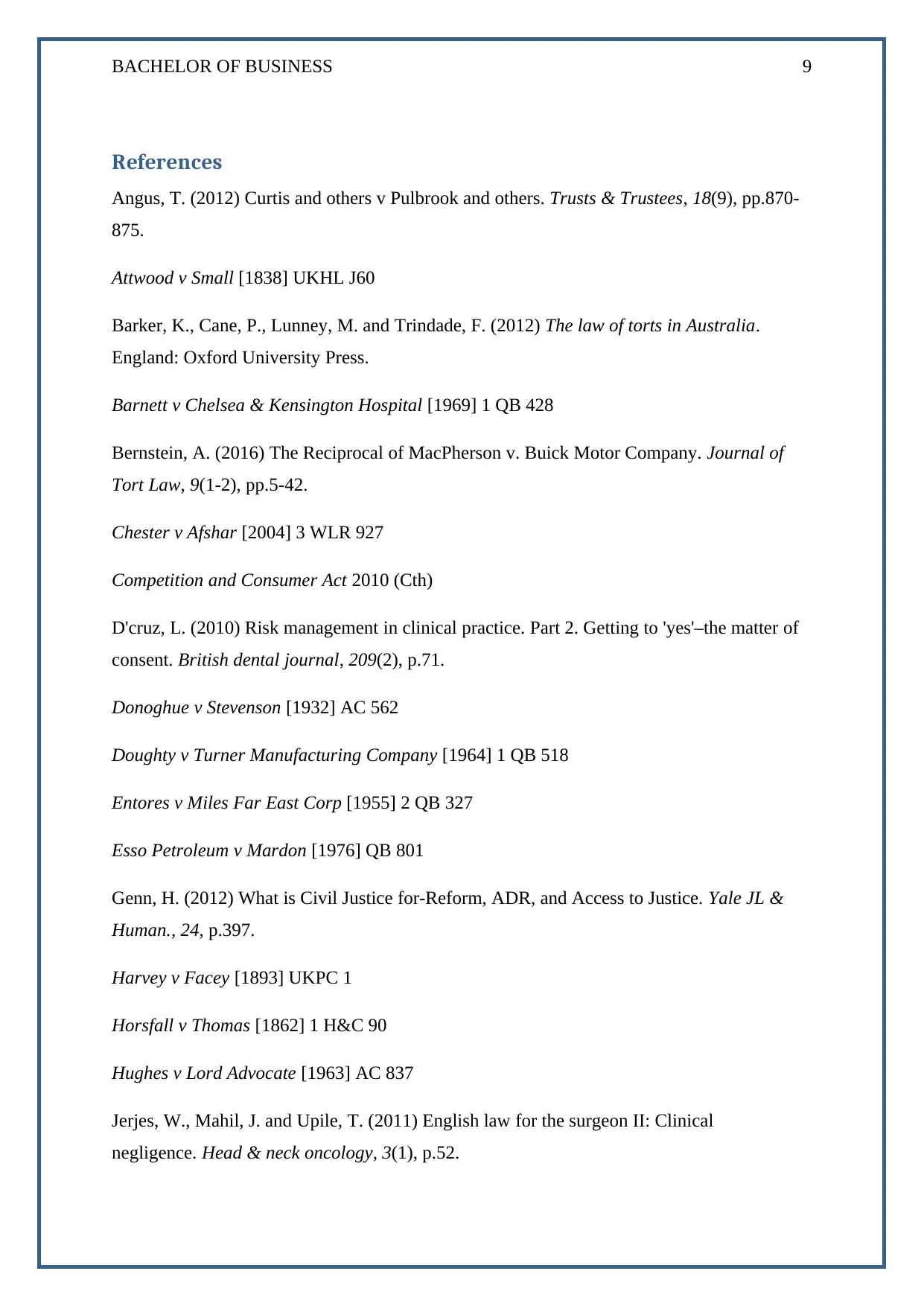
BACHELOR OF BUSINESS 9
References
Angus, T. (2012) Curtis and others v Pulbrook and others. Trusts & Trustees, 18(9), pp.870-
875.
Attwood v Small [1838] UKHL J60
Barker, K., Cane, P., Lunney, M. and Trindade, F. (2012) The law of torts in Australia.
England: Oxford University Press.
Barnett v Chelsea & Kensington Hospital [1969] 1 QB 428
Bernstein, A. (2016) The Reciprocal of MacPherson v. Buick Motor Company. Journal of
Tort Law, 9(1-2), pp.5-42.
Chester v Afshar [2004] 3 WLR 927
Competition and Consumer Act 2010 (Cth)
D'cruz, L. (2010) Risk management in clinical practice. Part 2. Getting to 'yes'–the matter of
consent. British dental journal, 209(2), p.71.
Donoghue v Stevenson [1932] AC 562
Doughty v Turner Manufacturing Company [1964] 1 QB 518
Entores v Miles Far East Corp [1955] 2 QB 327
Esso Petroleum v Mardon [1976] QB 801
Genn, H. (2012) What is Civil Justice for-Reform, ADR, and Access to Justice. Yale JL &
Human., 24, p.397.
Harvey v Facey [1893] UKPC 1
Horsfall v Thomas [1862] 1 H&C 90
Hughes v Lord Advocate [1963] AC 837
Jerjes, W., Mahil, J. and Upile, T. (2011) English law for the surgeon II: Clinical
negligence. Head & neck oncology, 3(1), p.52.
References
Angus, T. (2012) Curtis and others v Pulbrook and others. Trusts & Trustees, 18(9), pp.870-
875.
Attwood v Small [1838] UKHL J60
Barker, K., Cane, P., Lunney, M. and Trindade, F. (2012) The law of torts in Australia.
England: Oxford University Press.
Barnett v Chelsea & Kensington Hospital [1969] 1 QB 428
Bernstein, A. (2016) The Reciprocal of MacPherson v. Buick Motor Company. Journal of
Tort Law, 9(1-2), pp.5-42.
Chester v Afshar [2004] 3 WLR 927
Competition and Consumer Act 2010 (Cth)
D'cruz, L. (2010) Risk management in clinical practice. Part 2. Getting to 'yes'–the matter of
consent. British dental journal, 209(2), p.71.
Donoghue v Stevenson [1932] AC 562
Doughty v Turner Manufacturing Company [1964] 1 QB 518
Entores v Miles Far East Corp [1955] 2 QB 327
Esso Petroleum v Mardon [1976] QB 801
Genn, H. (2012) What is Civil Justice for-Reform, ADR, and Access to Justice. Yale JL &
Human., 24, p.397.
Harvey v Facey [1893] UKPC 1
Horsfall v Thomas [1862] 1 H&C 90
Hughes v Lord Advocate [1963] AC 837
Jerjes, W., Mahil, J. and Upile, T. (2011) English law for the surgeon II: Clinical
negligence. Head & neck oncology, 3(1), p.52.
Paraphrase This Document
Need a fresh take? Get an instant paraphrase of this document with our AI Paraphraser
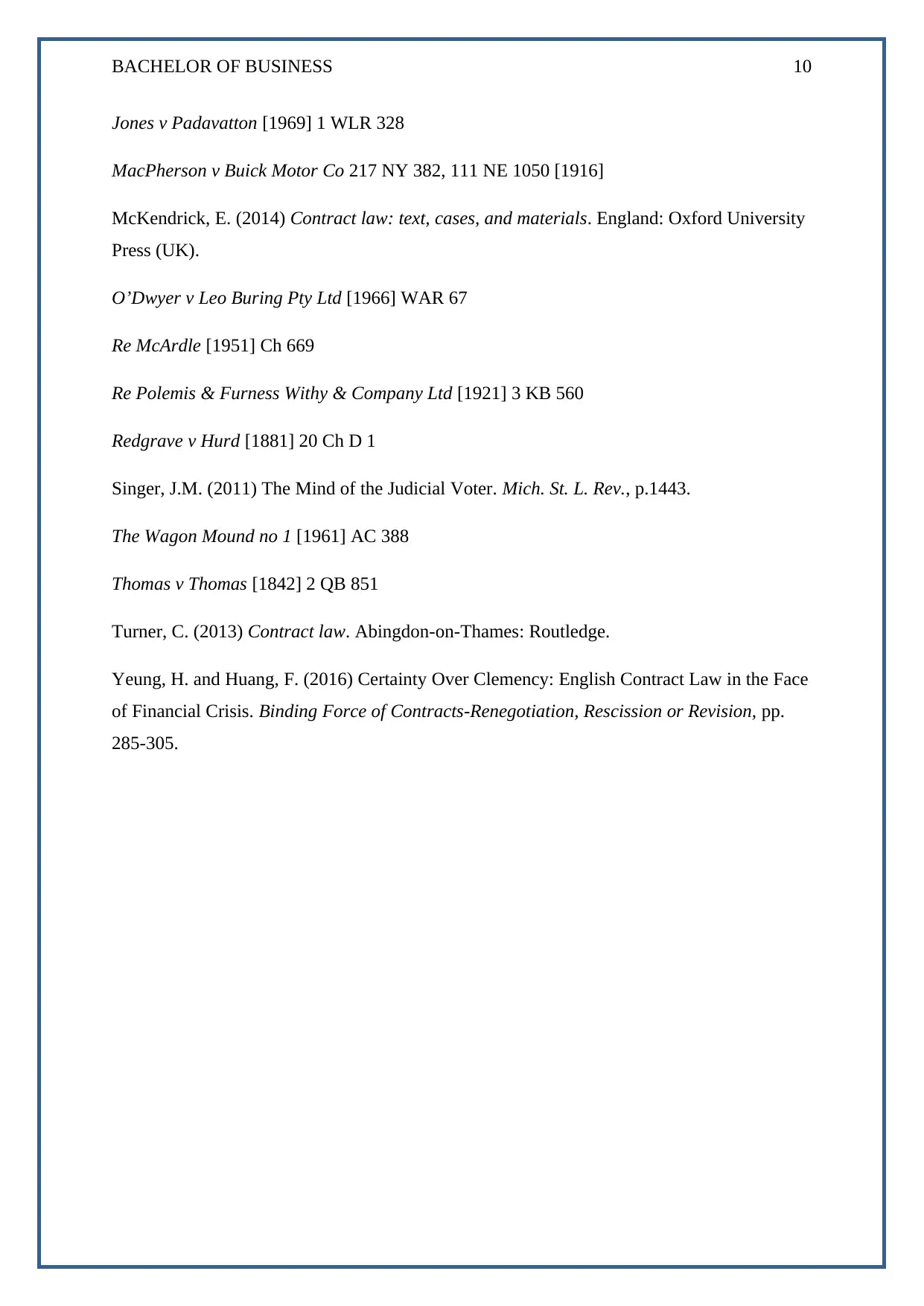
BACHELOR OF BUSINESS 10
Jones v Padavatton [1969] 1 WLR 328
MacPherson v Buick Motor Co 217 NY 382, 111 NE 1050 [1916]
McKendrick, E. (2014) Contract law: text, cases, and materials. England: Oxford University
Press (UK).
O’Dwyer v Leo Buring Pty Ltd [1966] WAR 67
Re McArdle [1951] Ch 669
Re Polemis & Furness Withy & Company Ltd [1921] 3 KB 560
Redgrave v Hurd [1881] 20 Ch D 1
Singer, J.M. (2011) The Mind of the Judicial Voter. Mich. St. L. Rev., p.1443.
The Wagon Mound no 1 [1961] AC 388
Thomas v Thomas [1842] 2 QB 851
Turner, C. (2013) Contract law. Abingdon-on-Thames: Routledge.
Yeung, H. and Huang, F. (2016) Certainty Over Clemency: English Contract Law in the Face
of Financial Crisis. Binding Force of Contracts-Renegotiation, Rescission or Revision, pp.
285-305.
Jones v Padavatton [1969] 1 WLR 328
MacPherson v Buick Motor Co 217 NY 382, 111 NE 1050 [1916]
McKendrick, E. (2014) Contract law: text, cases, and materials. England: Oxford University
Press (UK).
O’Dwyer v Leo Buring Pty Ltd [1966] WAR 67
Re McArdle [1951] Ch 669
Re Polemis & Furness Withy & Company Ltd [1921] 3 KB 560
Redgrave v Hurd [1881] 20 Ch D 1
Singer, J.M. (2011) The Mind of the Judicial Voter. Mich. St. L. Rev., p.1443.
The Wagon Mound no 1 [1961] AC 388
Thomas v Thomas [1842] 2 QB 851
Turner, C. (2013) Contract law. Abingdon-on-Thames: Routledge.
Yeung, H. and Huang, F. (2016) Certainty Over Clemency: English Contract Law in the Face
of Financial Crisis. Binding Force of Contracts-Renegotiation, Rescission or Revision, pp.
285-305.
1 out of 11
Related Documents
Your All-in-One AI-Powered Toolkit for Academic Success.
+13062052269
info@desklib.com
Available 24*7 on WhatsApp / Email
![[object Object]](/_next/static/media/star-bottom.7253800d.svg)
Unlock your academic potential
Copyright © 2020–2025 A2Z Services. All Rights Reserved. Developed and managed by ZUCOL.




